I recently discovered Captain Jack’s Deadweed Brew while battling an ever-growing invasion of weeds in my garden. After trying countless solutions, I can confidently say that this product is a game changer.
If you’re on the fence about what to use for weed control, I highly recommend giving this product a try. Its effectiveness and ease of use make it a must-have in your garden care arsenal.
Trust me—once you experience the benefits, you’ll wonder how you ever managed without it. Buy this product today and see the transformation for yourself!
My Journey With Deadweed Brew
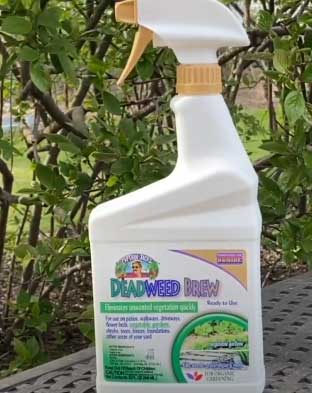
I started my journey with Captain Jack’s Deadweed Brew out of sheer desperation.
My garden, once a source of pride, was overrun by stubborn weeds that refused to leave no matter how hard I tried.
I had exhausted every other option—from traditional herbicides to more environmentally friendly solutions—but nothing provided the quick, reliable results I needed.
When I first read about Deadweed Brew’s fast-acting formula, I was intrigued.
The promise of seeing results in just a few hours, combined with its organic gardening approval, meant that I could protect both my plants and the environment.
I was especially drawn to the idea that it worked effectively even in lower temperatures, which suited my unpredictable weather perfectly.
Understanding The Deadweed Brew
Captain Jack’s Deadweed Brew is designed as a non-selective weed control solution. It targets non-selective herbaceous broadleaf and grassy weeds. The product is meant for visible weeds and is approved for organic gardening.
That means you can use it in vegetable and flower gardens without worrying about harmful chemicals affecting your produce. The formula mixes with water and is applied using a standard hand-held or backpack sprayer, making it incredibly easy to use.
The active ingredients, primarily saturated organic acids derived from coconut oil, are designed to be non-cancerous, non-persistent, and non-bioaccumulative. Although it is not OMRI certified, a closer look at the safety data shows that it poses minimal risks.
This reassured me that I could use it around my entire property, including areas near mature trees, driveways, and even around buildings.
The Application Process of Deadweed Brew
One of the first things I appreciated about Deadweed Brew was how simple it was to prepare and apply. Here’s how I used it:
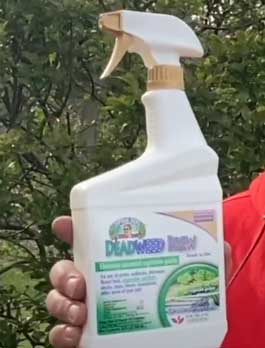
- Mixing the Solution: I followed the label instructions closely. Since it is a concentrate, I had to adjust the solution strength based on the type of weeds I was treating. For newly emerging weeds, I used a slightly higher concentration, while for established ones, I was cautious not to overdo it.
- Application Method: I used a standard backpack sprayer to apply the solution evenly. The formula spread well over the leaves of the weeds, coating them entirely. I noticed that within a few hours, the leaves began to show signs of distress—turning brown and crispy. This was a clear sign that the product was working.
- Re-application: Because the formula works on the leaves rather than the roots or seeds, I needed to monitor my garden closely. As new weed sprouts appeared, I re-applied the solution. Over time, the number of weeds decreased significantly, which reduced the amount of manual weeding I had to do.
- Spot Treatments: I also found that using the brew for spot treatments around driveways, sidewalks, and other hardscaped areas was very effective. It cleared out the weeds that would otherwise mar the look of these spaces.
Pros And Cons of Deadweed Brew
After several months of using Captain Jack’s Deadweed Brew, I’ve compiled a list of pros and cons based on my experience:
Pros
- Fast Acting: One of the standout features is how quickly the product works. Within hours, you can see significant damage to the weeds.
- Easy to Use: The product’s mixing and application process is straightforward, making it accessible even to those with little gardening experience.
- Versatile: I was able to use it in various settings, from vegetable gardens to driveways and even on the cracks of sidewalks.
- Organic Gardening Approval: Although it isn’t OMRI certified, its ingredients make it a safer choice for organic gardeners.
- Effective on Young Weeds: It works exceptionally well on newly emerging weeds like spurge, foxtail, and oxalis.
- Waterproof After Drying: Once the solution dries, it becomes waterproof, ensuring that the effects last even after rain.
- Environmentally Friendly: The organic acids used are derived from natural sources like coconut oil, which reassured me about the product’s environmental impact.
Cons
- Limited Effect on Established Grasses: While it performs well on new weeds, I noticed it wasn’t as effective on well-established grassy patches.
- Requires Multiple Applications: Since it targets the leaves, any new sprouts from seeds require additional treatments.
- Price: It is somewhat on the higher side compared to other weed killers, but the labor and time saved might justify the extra cost.
- Not OMRI Certified: For strict organic gardeners, the lack of OMRI certification might be a concern, even though the ingredients are largely safe.
- Selective Effectiveness: It doesn’t work on all types of weeds equally well, which means you need to know your enemy before application.
Tips For Using Deadweed Brew
Using Deadweed Brew effectively requires some regular maintenance and a few strategic steps. Here are some tips I learned along the way:
Monitoring and Timing
- Regular Checks: After each application, keep an eye on your garden. New sprouts can appear quickly, and early detection means you can treat them before they develop fully.
- Weather Considerations: The product works in temperatures as low as 40°F, but I found that early morning or late afternoon applications were most effective. This allowed the solution to work before the intense midday sun potentially degraded its efficacy.
- Post-Rain Re-application: Even though the product becomes waterproof once dry, heavy rainfalls might still encourage new weed growth. After significant rain, inspect your garden and reapply as needed.
Application Techniques
- Even Coverage: Ensure that the spray covers the entire leaf surface. In areas where weeds are densely packed, a second pass might be necessary.
- Spot Treatments: For isolated stubborn weeds, using a hand-held sprayer for spot treatments can be more effective than a broad application.
- Avoid Over-saturation: While it’s tempting to apply liberally, over-saturation can sometimes lead to run-off, wasting product and potentially harming nearby desirable plants.
Safety Measures
- Personal Protection: Even though the ingredients are generally safe, I always wore gloves and protective eyewear during application. This is especially important when mixing concentrated formulas.
- Storage: Keep the concentrate in a cool, dry place away from direct sunlight. I store mine in a locked cabinet to prevent accidental spills or misuse.
- Label Directions: I cannot stress this enough: always read and follow the label instructions. The manufacturer provides detailed guidelines that ensure you get the best results while minimizing any risks.
Environmental Considerations
- Selective Application: Use the product sparingly around areas where you want to encourage growth. Since it’s non-selective, a careful application will help preserve your desirable plants.
- Integrated Weed Management: I now combine Deadweed Brew with other gardening practices, such as mulching and manual weeding, to create a holistic approach to weed control. This integrated strategy has helped me reduce weed emergence over the long term.
My Personal Experience With Different Weed Types
I found that the product’s performance varied depending on the type of weed you’re dealing with. Here’s what I noticed:
- Newly-Emerging Weeds
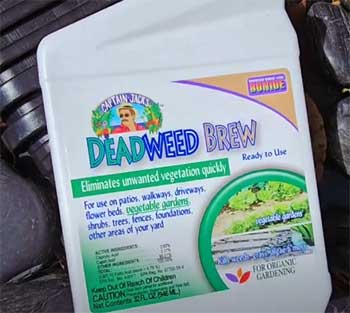
For weeds that are just starting to sprout, such as spurge, foxtail, and oxalis, the results were impressive.
The brew’s ability to “burn” the leaves quickly allowed me to identify missed spots within a couple of days.
With these new weeds, I could reapply the product on the affected areas and saw a marked reduction in weed density over time.
The quick feedback helped me perfect my application technique.
- Established Weeds
When dealing with established weeds or more robust species like common mallow, I noticed that the brew was less effective. In such cases, even thorough saturation did not always result in complete elimination.
However, I did find that repeated applications gradually weakened these persistent invaders. While it might not be a miracle cure for well-established weeds, the product still played a significant role in reducing their overall prevalence, making my gardening tasks more manageable.
- Weeds in Hardscape Areas
Another pleasant surprise was the product’s performance on weeds growing in cracks along driveways, sidewalks, and patios.
Unlike some herbicides that leave a residue, Deadweed Brew dried to form a waterproof barrier, effectively reducing the weed growth in these areas. This was especially useful in areas where I didn’t want to disturb the surrounding aesthetics.
Comparing Application Strategies
Over time, I experimented with various strategies for applying Deadweed Brew, each with its own set of benefits:
Concentration Variations
- Standard Concentration: For everyday maintenance and newly emerging weeds, I stuck to the recommended concentration. This provided consistent results without any adverse effects.
- Double Concentration: For particularly stubborn weeds or dense clusters, I tried a double concentration. This approach yielded better results in areas where the standard mix wasn’t sufficient. However, I was cautious not to overuse it, as this could potentially affect nearby desirable plants.
Frequency of Application
- Weekly Inspections: During peak growing seasons, I performed weekly inspections and applied the brew as necessary. This routine helped me stay ahead of the weeds before they could gain a foothold.
- Post-Event Applications: After events like heavy rain or unexpected weed bursts, I re-applied the solution to keep the weed population in check.
Complementary Weed Control Methods
- Mulching: I started using mulch in conjunction with the brew. The mulch helped suppress weed growth naturally, and when combined with the targeted action of Deadweed Brew, it created a healthier environment for my plants.
- Manual Weeding: Despite the product’s effectiveness, I still resorted to some manual weeding, especially in areas where precision was needed. This integrated approach has allowed me to maintain a cleaner garden with less overall effort.
Real-World Scenarios: Case Studies From My Garden
I’d like to share a few scenarios from my own gardening adventures where Deadweed Brew made a significant difference:
- The Overrun Front Yard
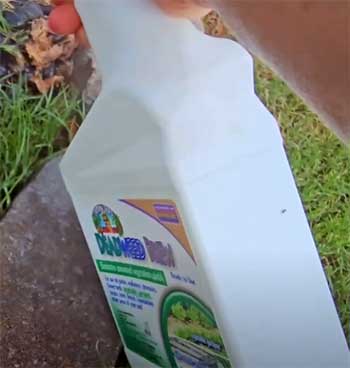
My front yard had become a battleground of invasive weeds that had taken over an untended lot next door.
I was overwhelmed by the sheer volume of weed seeds that had accumulated over the years.
After using Deadweed Brew for a few weeks, I saw a dramatic reduction in the number of weeds sprouting up.
Although I had to reapply the solution multiple times, the overall weed density dropped by nearly 70%.
This success made it much easier for me to introduce a drought-tolerant native landscape that I had been planning for years.
- Tackling Bermuda Grass
Bermuda Grass has always been a challenge, especially around my driveway. I used to struggle with it growing back quickly, making it nearly impossible to maintain a neat appearance.
When I applied Deadweed Brew—adjusting the concentration to suit the stubborn Bermuda Grass—I found that it killed the roots effectively, stopping the invasive growth in its tracks.
Although I had to be cautious not to let the spray contact the surrounding grass, the targeted application significantly improved the look of my driveway.
- Hardscape Weed Management
In my backyard, the cracks in the patio and walkway were a constant source of frustration. Traditional methods left behind a messy residue, but Deadweed Brew’s fast-drying and waterproof nature meant that once it dried, the weed growth was effectively halted.
I applied the brew using a hand-held sprayer, and within hours, the unsightly weeds were scorched away. This not only improved the aesthetics but also reduced my overall maintenance time.
The Science Behind the Action
Let’s talk a bit about why Captain Jack’s Deadweed Brew works so well. The active ingredients, which are saturated organic acids, interact with the cell membranes of the weeds.
When applied, these acids cause the membranes to break down, leading to rapid dehydration and ultimately, the death of the plant tissue. This process is visible within a short period, giving you clear evidence that the product is working.
The effectiveness of the formula is further enhanced by the surfactant that is included. This component helps the solution adhere to the leaves of the weeds, ensuring an even and thorough coverage. The combination of these ingredients makes Deadweed Brew an efficient solution for controlling a broad range of herbaceous and grassy weeds.
Adjusting Your Approach Based On Weed Type
Based on my experience, here’s how you can adjust your approach for different weed types:
- For Delicate Garden Areas: Use a lower concentration when treating weeds near delicate plants. This helps prevent accidental damage to your flowers or vegetables.
- For Heavily Infested Areas: Increase the concentration slightly for areas with dense weed growth. This might be necessary for well-established patches, but be sure to monitor the area for any collateral damage.
- For Hardscapes: Stick to the recommended mix since hardscape areas are less sensitive to any overspray. The waterproof nature of the dried brew ensures that the solution remains effective even in outdoor conditions.
Addressing The Cons: How I Managed Limitations?
No product is without its drawbacks, and I encountered a few limitations with Deadweed Brew. Here’s how I addressed them:
Managing Stubborn Weeds
For established grasses and common mallow, I found that a single application was not always sufficient. My strategy involved:
- Multiple Treatments: I applied the brew multiple times over a few weeks. Each round reduced the weed’s vitality, eventually leading to a noticeable decline.
- Targeted Applications: I used a hand-held sprayer for stubborn patches to ensure that I wasn’t wasting the product on areas where it wasn’t needed.
Cost Justification
While the cost might be a concern for some, I justified it by calculating the overall savings in time and labor. I kept a log of how many hours I would have spent hand-weeding compared to the time saved by using Deadweed Brew. The results were clear: the initial expense was more than offset by the reduced manual labor and improved garden aesthetics.
Organic Certification Concerns
For those worried about the lack of OMRI certification, I suggest focusing on the safety data and ingredient transparency. The organic acids used are derived from natural sources, and the product has been approved for organic gardening. In my experience, the benefits far outweigh the certification issue, especially when used responsibly.
Comparing Deadweed Brew With Other Brands
Over the years, I have tried several weed control products, and I found that Captain Jack’s Deadweed Brew holds its own against many well-known brands. Let me share my experiences comparing it with a couple of alternatives.
Deadweed Brew Vs. Scotts WeedEX Weed Killer
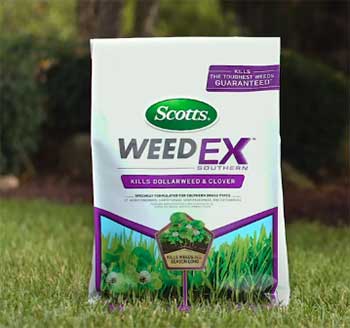
When I first encountered Scotts WeedEX, I was intrigued by its reputation for fast weed control.
However, after trying both, I found some clear differences. Scotts WeedEX tends to be effective on mature, established weeds, but its chemical composition sometimes left my surrounding plants at risk.
In contrast, Captain Jack’s Deadweed Brew worked quickly on emerging weeds, and its organic formulation gave me peace of mind when using it around my vegetable and flower gardens.
While WeedEX might edge out in tackling older weeds, I appreciated Deadweed Brew’s gentler, yet efficient, approach that helped me avoid collateral damage in sensitive areas.
- Deadweed Brew Vs. SpeedZone Lawn Weed Killer
SpeedZone Lawn Weed Killer is known for its speed in delivering results, and initially, that was a huge draw for me. However, as I experimented with both products, I noticed distinct differences.
SpeedZone works swiftly, but I often found that its rapid action didn’t offer enough control over which weeds were being targeted—sometimes even affecting non-target plants. On the other hand, Captain Jack’s Deadweed Brew provided a more visible, controlled “burn” effect that let me easily identify treated areas.
I appreciated that its action was primarily on the leaves, allowing me to reapply selectively to any new sprouts. Although SpeedZone might appeal to those who need immediate, broad-spectrum results, I valued Deadweed Brew’s nuanced approach, which ultimately saved me from having to redo sections of my garden multiple times.
- Deadweed Brew Vs. Scotts Triple Action Weed Killer
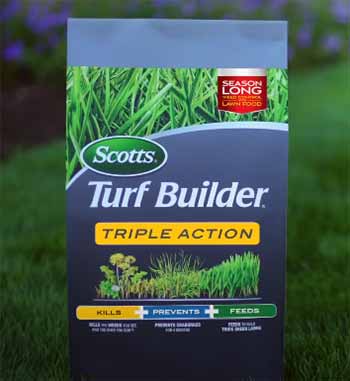
Scotts Triple Action Weed Killer promises a three-pronged approach by killing weeds, preventing regrowth, and even nourishing the lawn.
I was curious to see if the “triple action” lived up to its claims.
In my experience, Triple Action did manage to control the weeds, but its application was less precise—often affecting my desired grass.
With Captain Jack’s Deadweed Brew, I had more control over where and how the product was applied.
Its concentration-adjustable formula allowed me to target problem areas without the risk of over-spraying on healthy lawn sections.
Although Scotts Triple Action provides added benefits like lawn nutrition, for someone who prioritizes a targeted, organic weed control solution, Deadweed Brew offered a better balance between effectiveness and preserving my garden’s overall health.
Frequently Asked Questions (FAQ)
From my research and personal experience, Captain Jack’s Deadweed Brew is generally safe for pets when used as directed. However, it’s important to avoid allowing your pets near freshly treated areas until the solution has completely dried.
The product is approved for organic gardening, and its main ingredients are organic acids derived from coconut oil. Although it is not OMRI certified, its composition aligns with organic principles and is considered safe for organic use.
Using Deadweed Brew is straightforward. Mix the concentrate with water according to the label directions, and apply it using a standard hand-held or backpack sprayer. Ensure even coverage on the weeds, and reapply as necessary, especially after heavy rains or when new weed sprouts appear.
Yes, it works effectively on a variety of visible weeds and grasses. However, while it excels on newly emerging weeds and many broadleaf types, you may need to use a higher concentration or multiple applications for well-established or particularly stubborn weeds.
My Final Thoughts On Deadweed Brew
Over time, I’ve seen my garden transform from a battlefield of rampant weeds into a well-maintained, thriving space. Captain Jack’s Deadweed Brew has proven itself to be a reliable and efficient weed control solution.
Its fast-acting nature, ease of use, and versatility make it an indispensable tool for anyone serious about maintaining a beautiful garden. While there are a few limitations, the overall performance and positive environmental impact make it a product I can confidently recommend.
